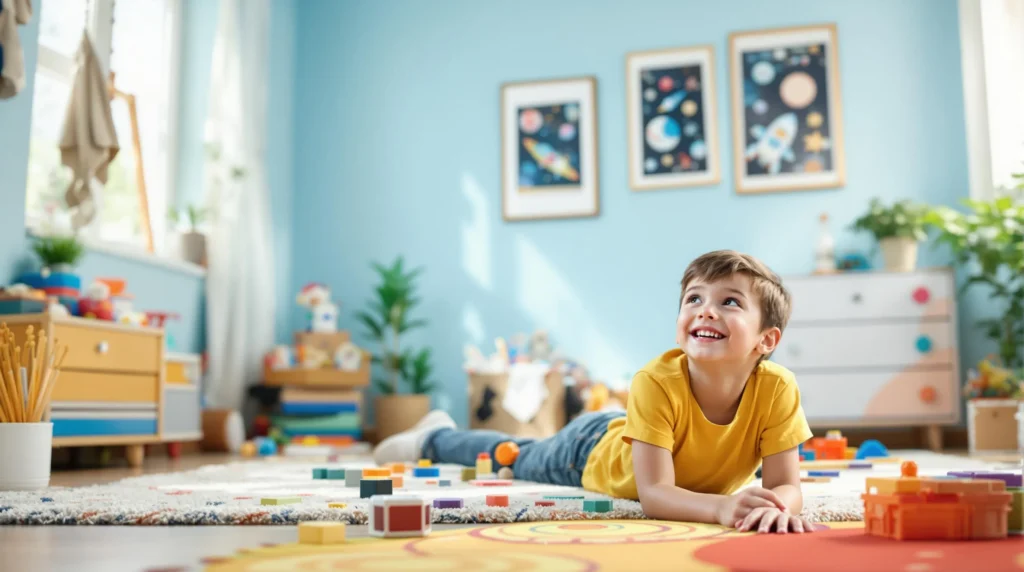Choosing the perfect paint color for your son’s room can transform an ordinary space into an inspiring haven that nurtures his personality and interests. We’ve researched the top paint colors that balance timeless appeal with current trends to help you create a space your boy will love.
Whether you’re designing a room for a toddler, tween, or teenager, the right color palette sets the foundation for a space that can grow with him. From calming blues and energizing greens to sophisticated neutrals, we’ll guide you through the best paint options that stimulate creativity, promote relaxation, and reflect your son’s unique character. Let’s explore these versatile color choices that will make your boy’s room both stylish and functional.
How to Choose the Best Paint Colors for Boys Room: A Complete Guide
Consider Your Child’s Age and Personality
When selecting paint colors for a boy’s room, we recommend starting with your child’s age and personality. Toddlers often respond well to bright, stimulating colors like primary blues and greens that encourage play and development. School-aged boys might prefer colors that reflect their emerging interests, such as deeper blues, greens, or even themed colors from favorite sports teams or characters. Teenagers typically appreciate more sophisticated color schemes that reflect their maturing tastes, including slate blues, muted greens, or neutral grays that create a more grown-up atmosphere.
Think About the Room’s Purpose
The function of the room should heavily influence your color choice. Bedrooms primarily used for sleeping benefit from calming colors like soft blues, gentle greens, or warm neutrals that promote rest. Study areas work best with focused colors such as light blues or greens that enhance concentration without causing distraction. Play spaces can handle more vibrant hues like energetic blues or playful greens that stimulate creativity and active engagement.
Test Before Committing
Paint colors can look dramatically different depending on lighting conditions and surrounding elements. We strongly advise purchasing sample pots and painting large swatches (at least 2 feet square) on different walls of the room. Observe these test patches at various times of day to see how natural and artificial lighting affects the color. This crucial step prevents costly mistakes and ensures the final result matches your expectations.
Consider the Long-Term
Choose colors with staying power that won’t quickly feel dated or childish. Navy blue, sage green, and warm grays offer timeless appeal that can transition through different developmental stages. These versatile options provide excellent foundations that allow for easy updates through accessories and decor as your child grows and his tastes evolve.
Factor in Room Size and Lighting
Room dimensions and natural light significantly impact how colors appear. Small rooms benefit from lighter shades that create an illusion of spaciousness and openness. Rooms with abundant natural light can support deeper, richer colors without feeling cramped. Conversely, north-facing rooms with limited sunlight often need warmer tones to counterbalance cool, shadowy conditions.
Coordinate with Existing Elements
Take inventory of permanent features in the room that cannot be easily changed. Flooring, trim color, furniture pieces, and architectural elements should complement your paint selection. Creating a cohesive color scheme ensures all elements work together harmoniously rather than competing for attention.
Incorporate Color Psychology
Colors profoundly affect mood and behavior. Blues typically create calm, focused environments ideal for restful sleep and concentrated study. Greens connect with nature, promoting balance and renewal. Neutrals provide versatile backdrops that support concentration while allowing personality to shine through other elements. Understanding these psychological effects helps create spaces that positively impact your son’s daily life.
Create Zones with Color
For multifunctional rooms, consider using different paint colors to designate exact areas. A slightly darker shade might define a reading nook, while a complementary color could highlight a desk area. This zoning technique helps organize the space visually and can make even small rooms feel more purposeful and well-designed.
Calming Blues: Perfect for Creating a Relaxing Atmosphere
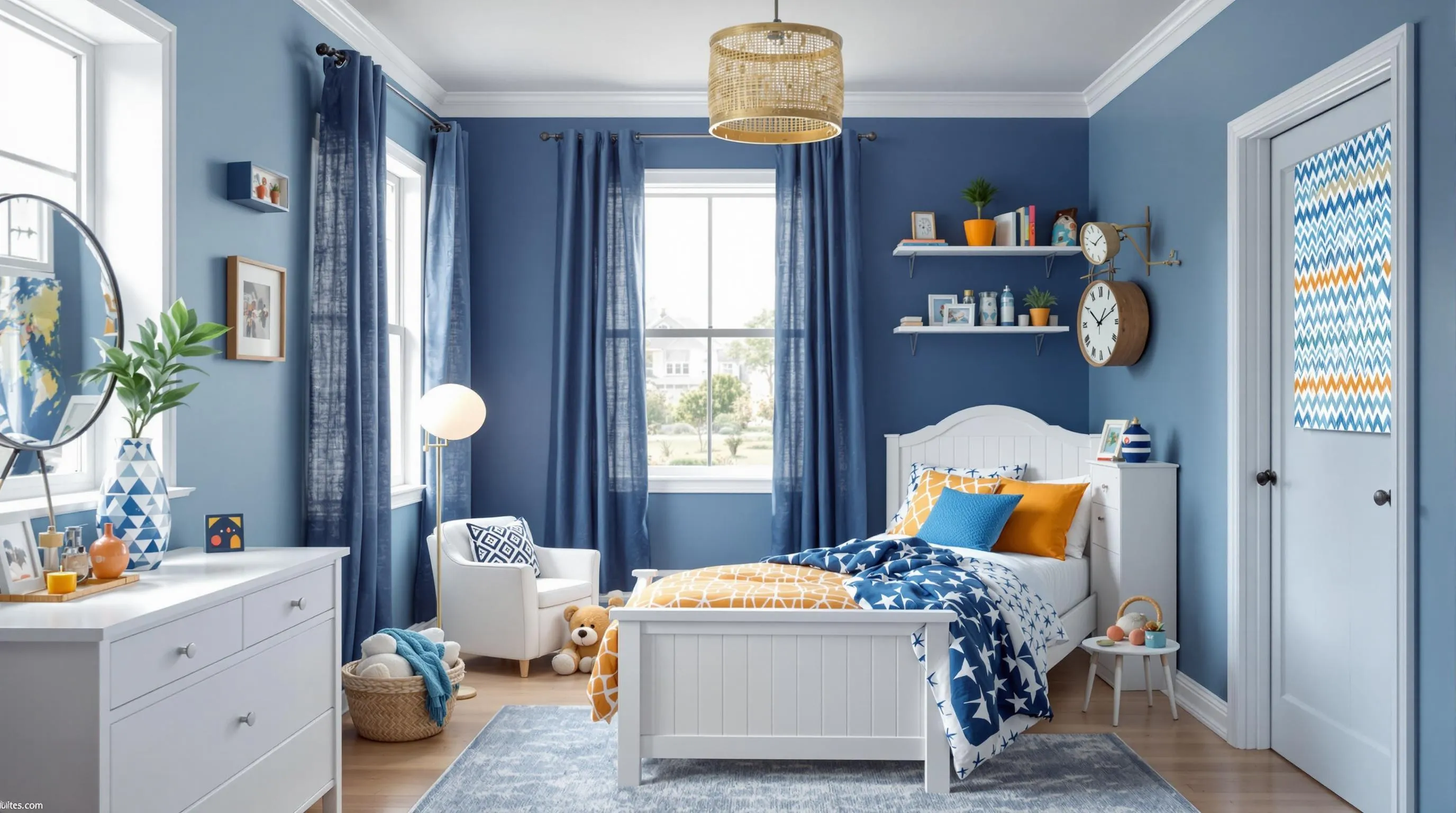
Blue paint colors stand out as ideal choices for boys’ rooms, offering both versatility and a soothing environment. These hues can transform a space from chaotic to calm while still maintaining a stylish appearance that works for various age groups.
Navy Blue: A Timeless Classic
Navy blue delivers a sense of stability and sophistication that works beautifully in boys’ rooms of all ages. This deep, rich tone creates a cozy atmosphere while providing a neutral backdrop that can easily transition from childhood to adolescence. When using navy blue, balance it with lighter accents like white trim or beige furnishings to prevent the space from feeling too dark or overwhelming. Many designers recommend navy for its ability to hide marks and scuffs, making it practical for active boys’ spaces while still maintaining an elegant appearance.
Sky Blue: Light and Airy Options
Sky blue introduces a light, airy feel that instantly opens up a room and creates a peaceful environment. This shade mimics the open sky, promoting a sense of freedom and tranquility that helps reduce stress and minimize tantrums in younger boys. For the best effect, pair sky blue with white furniture or window treatments to enhance the room’s brightness. Soft, powder blue variations work exceptionally well in smaller rooms where darker colors might feel confining. These lighter blue tones provide the perfect canvas for colorful accents while maintaining the calming properties that make blue such a popular choice for children’s bedrooms.
Energetic Greens: Bringing the Outdoors Inside
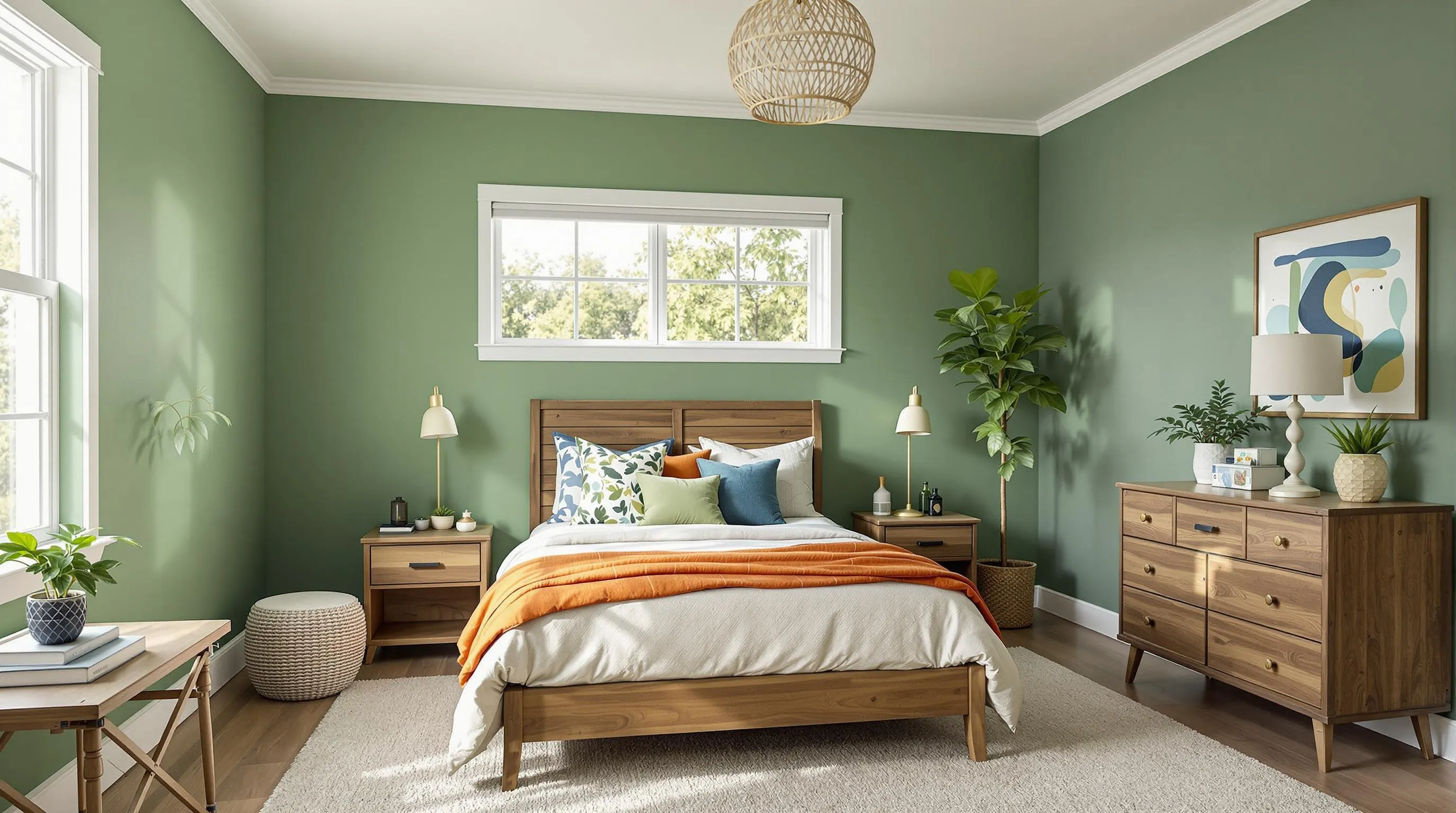
Green tones offer a perfect balance of energy and tranquility for boys’ rooms, effectively bringing natural elements indoors. These nature-inspired hues create spaces that feel both refreshing and grounded, making them ideal choices for growing boys.
Pewter Green: Versatile and Sophisticated
Pewter Green from Sherwin-Williams stands out as an exceptionally versatile choice for boys’ rooms of all ages. This rich, muted shade adapts beautifully to various decorating styles, from traditional to contemporary designs. We’ve found that Pewter Green creates a sophisticated backdrop that works well with wooden furniture, neutral bedding, and pops of brighter accent colors. This shade provides enough character to make a statement while remaining neutral enough to grow with your child through different phases.
Olive Green: Creating a Tranquil Retreat
Benjamin Moore’s Dark Olive transforms a boy’s room into a peaceful sanctuary with its deep, earthy undertones. This rich green shade evokes the feeling of forests and outdoor adventures, perfect for nature-loving boys. Dark Olive pairs wonderfully with natural textures like wood, leather, and woven elements to enhance its organic appeal. The warmth of this color makes it particularly suitable for rooms with ample natural light, where it creates a cozy yet sophisticated atmosphere that appeals to boys from elementary age through the teenage years.
Sage Green: A Subtle Nature-Inspired Choice
Sage green offers a subdued, calming presence that works beautifully in boys’ bedrooms while maintaining a connection to the natural industry. This versatile shade provides enough color interest without overwhelming the space, making it perfect for children who might be sensitive to overly bright environments. Sage green walls complement a wide range of accent colors, including navy, rust, and warm neutrals. We recommend this shade particularly for smaller rooms where its light-reflecting qualities can help the space feel more open while still providing character and warmth.
Mint Green: Fresh and Versatile
Mint green brings a refreshing, invigorating energy to boys’ rooms while maintaining a soothing quality that promotes relaxation. Though not traditionally associated with boys’ spaces, this unconventional choice offers a modern approach that works wonderfully for creative children. Mint walls create a perfect backdrop for darker furniture pieces and bold accent colors like navy, charcoal, or even orange. This color works especially well in rooms with limited natural light, where its brightness can help counteract darker conditions while creating a cheerful, inviting atmosphere that encourages both play and rest.
Neutral Foundations: Versatile Colors That Grow with Your Child
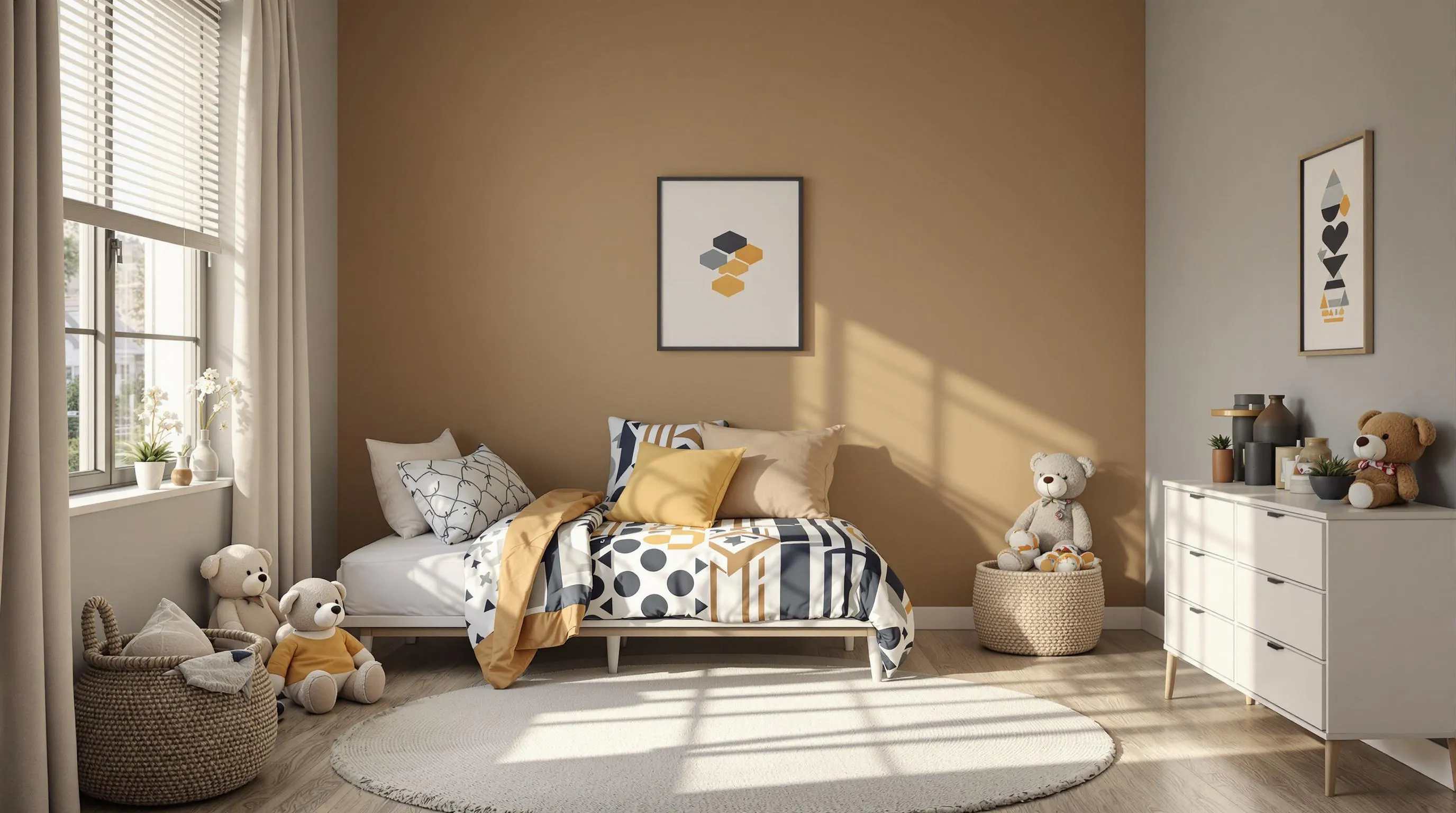
When designing a boy’s room that will stand the test of time, neutral colors provide the perfect foundation. These versatile shades offer longevity and adaptability, serving as an excellent backdrop for changing interests and evolving tastes.
Warm Gray: The Modern Neutral
Warm gray stands out as one of the most versatile paint choices for a boy’s room, offering a contemporary canvas that works beautifully for children of all ages. This sophisticated neutral creates a balanced backdrop that accommodates diverse decorative elements as your child grows and their interests change. Unlike cooler grays that can sometimes feel stark, warm gray infuses the space with subtle comfort while maintaining a modern aesthetic. Parents appreciate its ability to hide minor scuffs and marks better than pure whites, making it a practical choice for active boys’ rooms. The adaptability of warm gray allows it to pair effortlessly with bold accent colors through accessories, furniture, and artwork, enabling easy room updates without repainting.
Taupe: Sophisticated and Adaptable
Taupe brings a refined earthiness to boys’ rooms that’s both timeless and adaptable to various design themes. This sophisticated neutral features subtle brown-gray undertones that create a warm, inviting atmosphere while providing a versatile backdrop for changing decorative styles. Taupe works exceptionally well in spaces that require longevity, as it complements many color schemes from bold primary colors to more subdued palettes. The earthy qualities of taupe make it particularly suitable for nature-inspired room designs or spaces that incorporate natural materials like wood and leather. Its depth and richness offer more character than standard neutrals while still maintaining the versatility needed for a growing child’s room. Many designers recommend taupe for its ability to transition seamlessly from playful childhood spaces to more mature teenage retreats without requiring a complete room makeover.
Bold Accent Choices: Statement Colors That Pop

While calming neutrals and tranquil blues have their place, sometimes a boy’s room calls for something with more visual impact. Bold accent colors can energize a space and reflect a vibrant personality.
Deep Red: Adding Warmth and Energy
Deep red tones like those offered by Benjamin Moore create instant warmth and energy in a boy’s bedroom. These rich shades work exceptionally well in nautical-themed spaces, providing the perfect contrast against navy blue or crisp white elements. Red stimulates activity and conversation, making it ideal for play areas or social zones within the room. For best results, we recommend using red as an accent wall rather than painting the entire room, which allows the bold color to make a statement without overwhelming the space. Pair this powerful hue with neutral furnishings to balance its intensity and create a sophisticated yet playful atmosphere.
Mustard Yellow: Cheerful and Stimulating
Mustard yellow offers a surprising yet effective choice for boys’ rooms, bringing cheerful energy that stimulates creativity and imagination. Though not traditionally associated with boys’ spaces, this warm, golden tone creates a modern look that works across various age groups. Mustard yellow pairs beautifully with grays, blues, and even deep greens, making it versatile for different design schemes. The color promotes positivity and optimism while maintaining a sophisticated edge that won’t feel childish as your son grows. We’ve found this shade particularly effective in rooms with limited natural light, as it mimics sunshine and creates a welcoming, cozy atmosphere even on gloomy days.
Cool-Toned Options: Modern and Sophisticated Selections
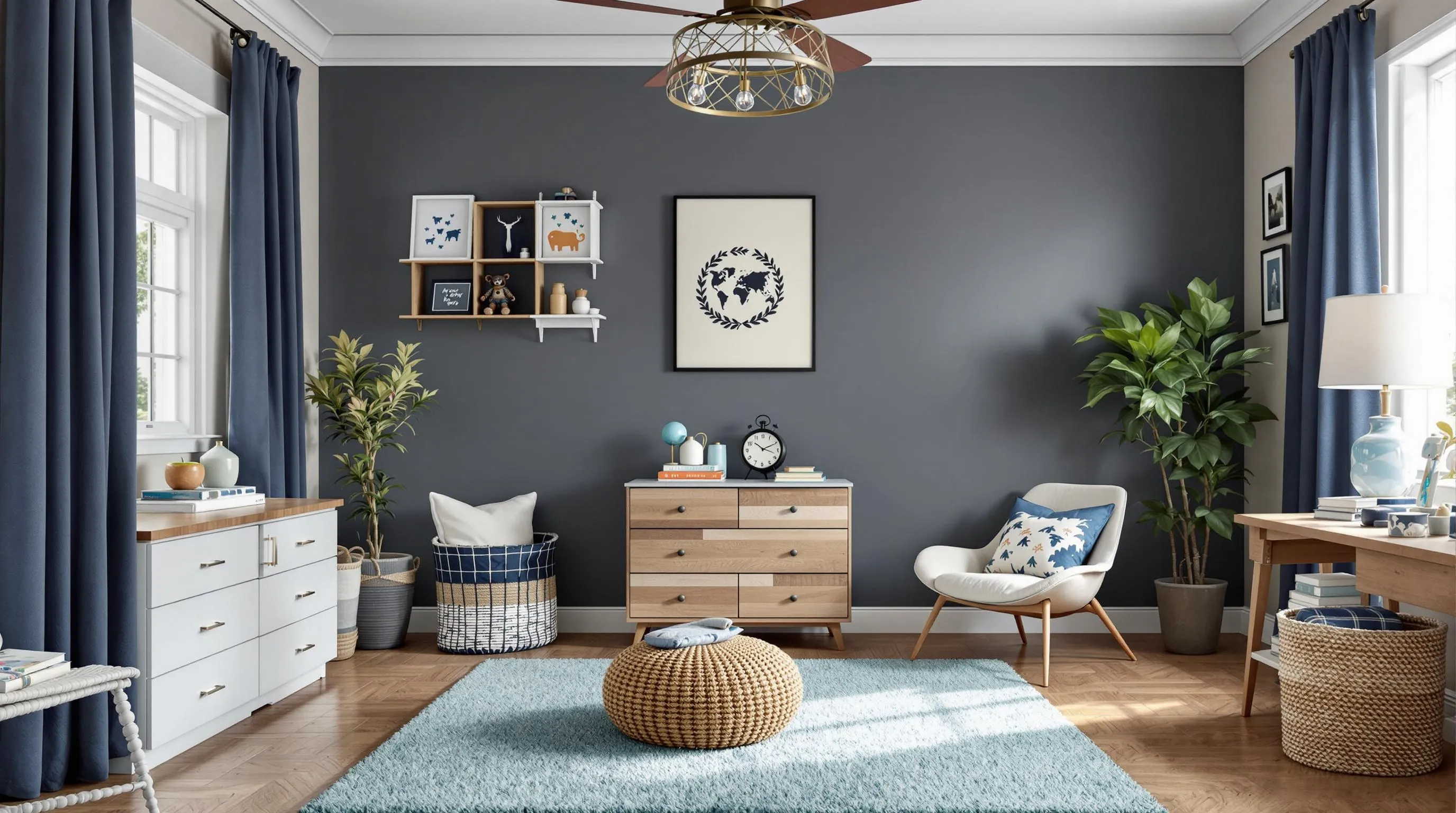
Cool-toned paint colors create a sophisticated and contemporary environment for boys’ rooms. These shades offer versatility while maintaining a modern aesthetic that can grow with your child.
Slate Gray: Contemporary and Mature
Slate Gray delivers a contemporary and mature look that works perfectly in boys’ rooms of various ages. This versatile shade pairs exceptionally well with different accent colors, allowing you to create a cohesive design that reflects your son’s personality. We recommend Slate Gray for older boys who prefer a more grown-up space or for rooms that need a neutral backdrop that can evolve over time. Adding colorful accessories against this sophisticated background creates a balanced aesthetic that isn’t overwhelming.
Indigo: Rich and Dramatic
Indigo makes a bold statement in any boy’s room with its rich and dramatic effect. This deep blue-purple hue adds important depth to the space, creating a cozy yet sophisticated atmosphere. We find that Indigo works particularly well as an accent wall behind the bed or desk area, where it can serve as a striking focal point. The intensity of this color pairs beautifully with lighter neutrals and metallic accents, bringing balance to the room’s overall design.
Navy Blue: Timeless Elegance
Navy Blue stands as a timeless and classic choice that brings both calming energy and elegance to a boy’s room. This versatile shade creates the perfect backdrop for gold or brass accents, establishing a sophisticated feel that works for various age groups. Navy walls provide a sense of security and stability, making this color especially suitable for bedrooms where relaxation is key.
Teal: Vibrant Yet Soothing
Teal colors like Sherwin-Williams’ Reflecting Pool and Peacock Blue offer a unique blend of blue and green tones that energize a space while maintaining a soothing atmosphere. This versatile shade works wonderfully in rooms that need a pop of color without overwhelming the senses. Teal adapts beautifully to different lighting conditions and complements wooden furniture exceptionally well.
Gray Owl: Subtle Versatility
Gray Owl by Benjamin Moore provides a soft, gray backdrop that works with virtually any design scheme. This subtle neutral creates a versatile foundation that easily adapts to changing interests and decor preferences. We’ve found that Gray Owl presents just enough color to avoid feeling stark while remaining neutral enough to complement bold accessories or furniture pieces.
Theme-Based Color Schemes: Coordinating with Interests
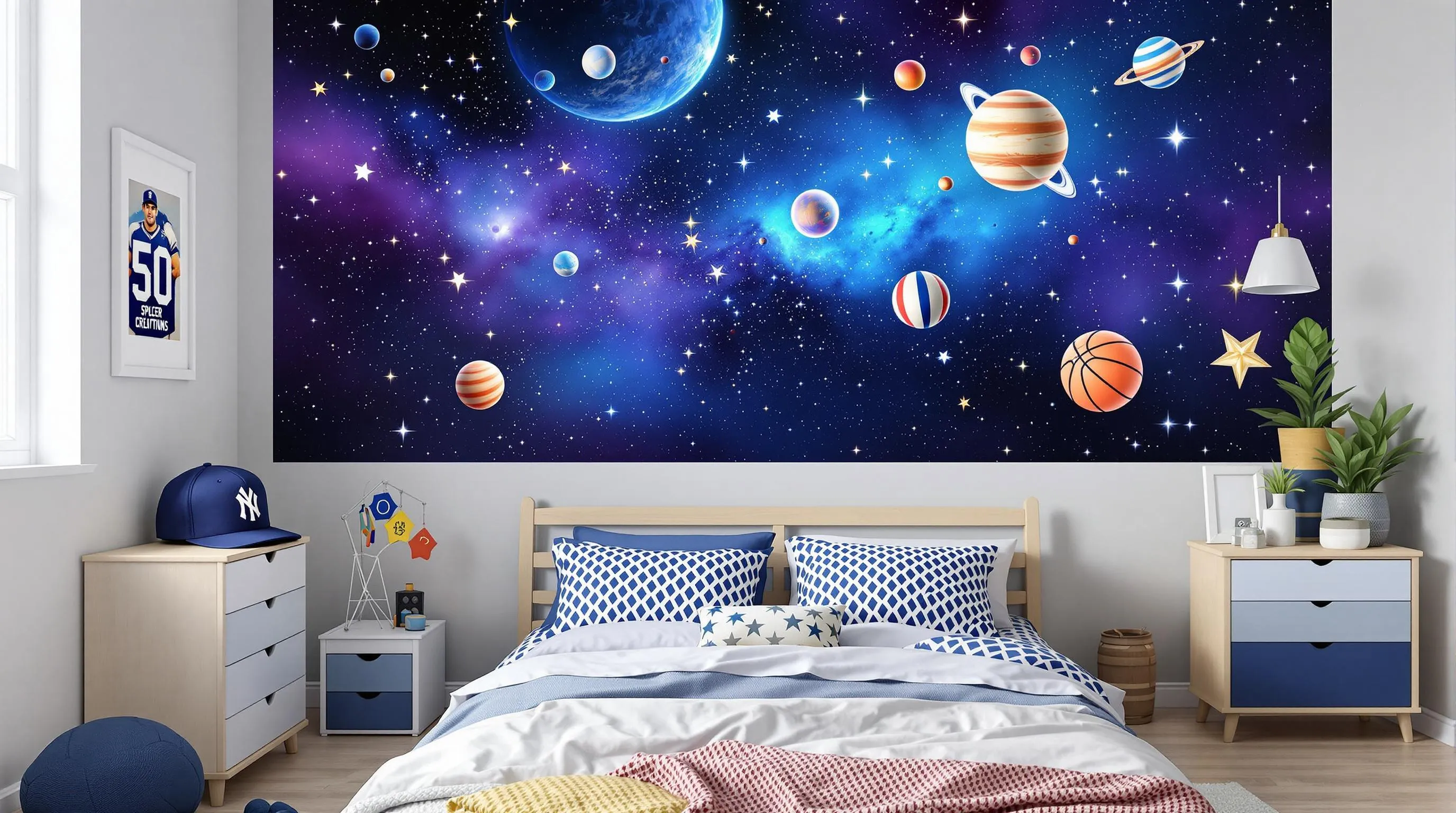
Creating a room that reflects your son’s passions can make the space feel more personal and special. Theme-based color schemes offer an excellent way to incorporate his interests while maintaining a cohesive look.
Space-Themed: Cosmic Blues and Purples
Cosmic blues like Sherwin-Williams’ Delft create the perfect backdrop for young astronomers and space enthusiasts. These deep blue shades evoke the vastness of the night sky, providing an immersive environment for imagination to flourish. Deep purples complement these blues beautifully, adding dimension that resembles distant galaxies and nebulae. Together, these colors establish a celestial atmosphere that encourages dreams of exploration and adventure. Stars, planets, and spacecraft décor elements stand out dramatically against these rich, dark backgrounds, completing the outer space experience in your child’s personal universe.
Sports-Inspired: Team Colors and Energetic Combinations
Incorporating favorite team colors transforms a bedroom into a personal fan zone that celebrates your child’s sporting passions. Red and white walls for baseball lovers or blue and orange for basketball enthusiasts create an immediate connection to their favorite sports. Energetic color combinations featuring bold reds or vibrant oranges paired with neutral backgrounds strike the perfect balance between excitement and comfort. These lively shades inject energy into the space without overwhelming it, making the room feel ever-changing yet livable. Neutral companions like soft beige or warm gray provide much-needed visual rest and versatility, allowing sports memorabilia and themed accessories to take center stage without competing with the walls.
Color Psychology for Boys Rooms: What Different Colors Communicate

Calming Blues
Blues significantly impact mood and behavior in a boy’s room, creating a peaceful atmosphere that promotes relaxation. Research shows blue actually reduces tantrums by physically lowering heart rate and blood pressure. Soft and light blue tones work particularly well for creating serene environments where children can unwind after a busy day. We’ve found that blue consistently ranks as one of the most effective colors for bedrooms because it reassures children and helps establish healthy sleep patterns. Consider pairing blue with warmer neutral tones like beige to prevent the space from feeling too cool or clinical.
Balanced Greens
Green offers the perfect balance between stimulation and relaxation, making it ideal for study areas in boys’ rooms. Forest green provides stability and calmness while still keeping the mind alert enough for assignments and learning activities. Many parents report that green spaces help their sons concentrate better on tasks while maintaining a connection to nature. The refreshing qualities of green make it versatile enough for both play spaces and quiet reading corners. This color works exceptionally well in rooms that overlook natural settings, creating a seamless indoor-outdoor connection.
Versatile Neutrals
Neutral colors like off-whites and light grays create an expansive, calm foundation that can evolve with your son’s changing interests. These versatile shades make small rooms appear larger and brighter while providing a blank canvas for more expressive decor elements. Many designers recommend neutrals for long-term planning, as they accommodate changing preferences without requiring complete room makeovers. Light gray walls can be easily complemented with colorful accessories that reflect current interests and can be updated as hobbies change. The simplicity of neutrals also helps reduce visual stimulation, which can benefit children who are easily overwhelmed.
Energizing Brights
Bright colors such as red and yellow should be used strategically rather than as primary wall colors in boys’ rooms. These energizing shades can stimulate activity and creativity but may interfere with relaxation when used extensively. Psychology research indicates that bright colors work best as accents in play areas or on feature walls rather than throughout entire bedrooms. Many parents find success incorporating these vibrant tones through furniture, artwork, or accessories instead of paint. The key to using bright colors effectively lies in balance—pairing them with more subdued tones prevents the space from becoming overwhelming.
Creating Color Balance
Achieving the right color balance means combining bold statement colors with calming neutrals to create a harmonious environment. For instance, pairing a blue accent wall with warm beige can enhance the room’s overall ambiance without overwhelming the senses. We recommend incorporating your son’s personality into color choices while still maintaining a cohesive design scheme. As children grow, involving them in color decisions helps create a space that feels personally meaningful and supportive. Remember that lighting dramatically affects how colors appear, so always test paint samples under different lighting conditions before making final decisions.
Practical Considerations: Paint Finishes and Durability for Active Boys
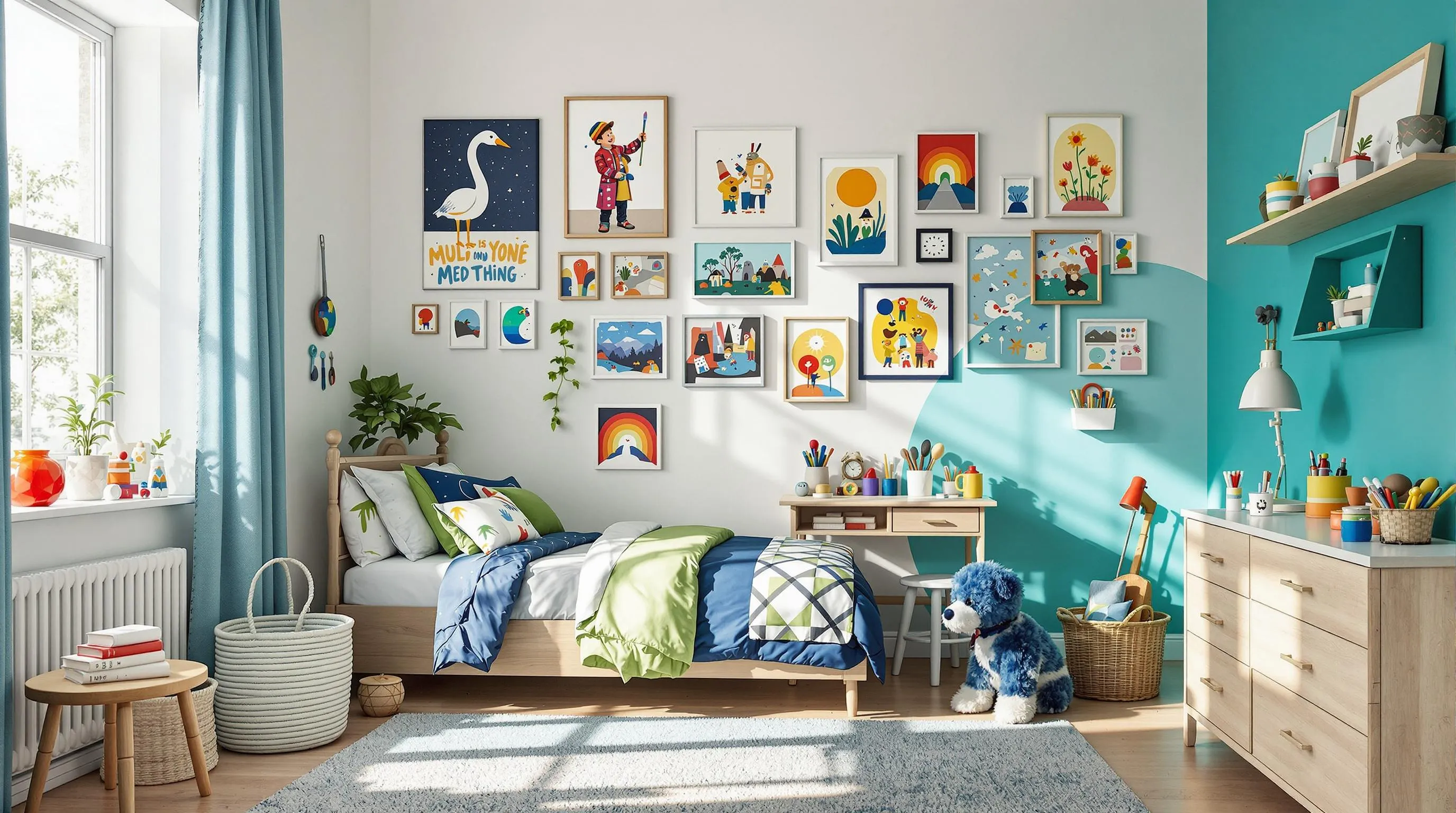
Boys’ rooms often endure important wear and tear, making your choice of paint finish just as important as the color itself. Selecting the right finish ensures walls can withstand rough play, improper cleaning attempts, and creative artwork that wasn’t exactly commissioned. We’ve compiled essential information about finishes and durability factors to help you make the most practical choice for your active boy’s room.
Best Paint Finishes for Boys’ Rooms
Eggshell or Satin Finishes
These finishes strike an ideal balance between durability and aesthetics for wall surfaces in boys’ rooms. Eggshell provides a subtle sheen that’s more washable than flat paint while maintaining a sophisticated look. Satin offers slightly more shine and better resistance to scrubbing, making it perfect for active boys who might accidentally bump or mark walls frequently.
Semi-Gloss Finish
This higher-sheen option is recommended specifically for trim, doors, and window frames in boys’ rooms. Semi-gloss finishes excel at resisting scuffs and smudges that commonly occur around doorways and high-touch areas. Their smooth surface allows for quick and easy cleaning, often requiring just a damp cloth to remove fingerprints or dirt without damaging the paint.
Eco-Friendly Options
Benjamin Moore’s Eco Spec® Interior Paint represents an excellent choice for health-conscious parents. This product features zero VOCs (volatile organic compounds) and minimal odor, creating a healthier environment while still offering the durability needed for active spaces. Your son’s room remains free from potentially harmful chemicals without sacrificing the paint’s ability to withstand daily wear.
Durability Factors to Consider
Washability Rating
Paint manufacturers often provide washability ratings for their products, indicating how well they stand up to cleaning. For boys’ rooms, selecting paints with high washability ratings ensures that occasional crayon marks or mysterious smudges can be removed without damaging the finish or color.
Stain Resistance
Some premium paints now include enhanced stain-resistant technology. These formulations prevent common stains from penetrating the paint surface, making cleanup significantly easier when accidents happen. The investment in quality paint often pays off through extended durability and reduced need for touch-ups.
Color Longevity
Colors like Sherwin-Williams Cloudburst (vibrant teal) and Benjamin Moore Labrador Blue maintain their vibrancy over time, even with frequent cleaning. These pigment-rich options resist fading from sunlight exposure or repeated washing, ensuring the room looks fresh for years rather than months.
Application Tips for Maximum Durability
Proper Surface Preparation
Thoroughly clean and prime walls before applying paint to ensure maximum adhesion and longevity. Small imperfections should be filled and sanded, creating a smooth surface that will better resist damage and be easier to clean in the future.
Multiple Coat Application
Applying two coats of quality paint creates a more durable surface than a single coat. The additional layer provides extra protection against wear and makes colors appear richer and more consistent throughout the room.
Accent Wall Strategy
Using bolder colors like Sherwin-Williams Peacock Blue on a single accent wall allows you to incorporate vibrant shades without overwhelming the space. This approach also concentrates the most durable paint finishes in high-traffic areas, where they’ll provide the most benefit.
By carefully considering these practical aspects alongside your color choices, you’ll create a room that not only looks great but also stands up to the energetic lifestyle of boys, requiring less maintenance and fewer repaints as they grow.
Conclusion: Creating a Space That Grows with Your Child
Choosing the perfect paint color for your son’s room is about balancing aesthetics with practicality. We’ve explored options from calming blues and versatile greens to sophisticated neutrals and energizing accents that suit different ages and personalities.
Remember that the best color choices reflect your child’s unique character while providing room to grow. Whether you opt for timeless navy blue or adaptable warm gray consider both current preferences and future needs.
By selecting durable finishes and involving your child in the decision-making process you’ll create more than just a stylish space—you’ll build an environment that supports development creativity and comfort. The right paint color transforms a simple room into a personal sanctuary where your son can thrive at every stage of childhood.
Frequently Asked Questions
What are the best paint colors for a young boy’s room?
The best paint colors for young boys include calming blues like Navy and Sky Blue, energetic greens such as Mint and Sage, and versatile neutrals like Warm Gray and Taupe. For toddlers, bright colors work well, while school-aged boys might prefer colors reflecting their interests. Teenagers typically appreciate more sophisticated options like Slate Gray or Indigo.
How does color psychology affect a boy’s room design?
Color psychology plays a significant role in room design. Blues create peaceful atmospheres and promote relaxation. Greens enhance concentration and maintain connection to nature, making them perfect for study areas. Neutrals provide adaptability and a calm foundation. Bright colors like red and yellow can stimulate creativity but should be used as accents to avoid overwhelming the space.
Should I consider room size when choosing paint colors?
Absolutely. Lighter shades make small rooms appear more spacious, while darker colors can make large rooms feel cozier. For rooms with limited natural light, warmer tones create a welcoming atmosphere. Always test colors under different lighting conditions throughout the day to ensure they achieve the desired effect in your specific space.
How can I create a theme-based color scheme for my son’s room?
Create theme-based colors by reflecting your son’s interests. For space enthusiasts, use cosmic blues and purples reminiscent of the night sky. Sports fans might enjoy team colors incorporated with neutral backgrounds. Balance vibrant theme colors with neutral elements for a cohesive look that celebrates your child’s passions while maintaining a livable space.
What paint finishes are best for durability in boys’ rooms?
For active boys’ rooms, choose eggshell or satin finishes for walls as they balance durability with aesthetics and are easier to clean. Use semi-gloss finishes for trim and high-touch areas for maximum washability. Look for paints with high washability ratings and stain resistance. Proper surface preparation and multiple coat application ensure longer-lasting results.
How can I involve my son in the paint color selection process?
Involve your son by presenting a pre-selected range of age-appropriate color options. For younger children, limit choices to 2-3 options to prevent overwhelming them. For older boys, discuss how colors might affect mood and function. Consider starting with a color that reflects his interests, then build a palette around it with complementary shades.
Can I use more than one color in my son’s room?
Yes, using multiple colors can create visual interest and define different zones in a multifunctional room. Consider an accent wall in a bolder shade while keeping other walls neutral. For optimal results, follow the 60-30-10 rule: 60% dominant color (walls), 30% secondary color (furniture), and 10% accent color (accessories) to achieve a balanced, cohesive look.
How do I ensure the paint color will grow with my son?
Choose timeless colors rather than trendy options that might quickly feel outdated. Neutral foundations like Warm Gray or Taupe adapt easily as interests change. Consider the room’s long-term purpose and select colors with versatility. If using bold colors, incorporate them through easily changeable elements like accent walls or accessories rather than entire room coverage.
Are there eco-friendly paint options that are safe for children’s rooms?
Yes, many brands now offer low-VOC or zero-VOC paints that reduce harmful emissions and are safer for children’s health. Options like Benjamin Moore’s Eco Spec® Interior Paint provide durability without compromising air quality. Look for paints labeled with environmental certifications like Greenguard Gold to ensure they meet strict standards for sensitive environments like children’s rooms.
How do lighting conditions affect paint color appearance?
Lighting dramatically affects how paint colors appear. Natural daylight shows the truest color, while incandescent lighting brings out warm tones and fluorescent lighting enhances cool tones. Always test paint samples on different walls and observe them at various times of day before making your final decision. This prevents costly mistakes and disappointment with the finished result.

